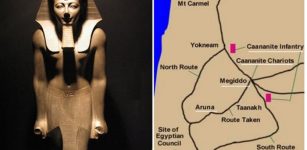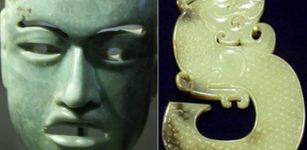Triumvirates In Ancient Rome: Power Struggle, Intrigue And Ambush
Conny Waters - AncientPages.com - A triumvirate (in Latin' tre viri' - three-man - or 'triumviri') was a board of three officials who shared a position of authority or power in ancient Rome.
Lepidus, Octavian and Mark Antony make a list of names of the most important Romans, whom they can execute with impunity and expropriate their property (the second triumvirate). Image credit: Rijksmuseum -Credit line: Schenking van J.J. de Man, Ede - CC0 1.0 DEED
A political agreement between these statesmen enabled them to govern together so that "nothing in the republic could happen without their consent."
The "First Triumvirate," also known as - the alliance of 'three' - was an unofficial arrangement made in 60 BC by Gnaeus Pompeius Magnus (Pompey' the Great'), Gaius Julius Caesar, and Marcus Licinius Crassus.
These three strong political leaders could control the Roman political system and support each other to achieve their goals.
This "first alliance of three" lasted until the death of Crassus, who started an unwarranted invasion of Parthia and was killed in 53 BC during the Battle of Carrhae (now Harran Southeastern Anatolia, Turkey.
Caesar's triumphant military campaigns in Gaul and Pompey's persistent pursuit of more alliances to weaken Caesar unintentionally paved the way for a conflict. Pompey was defeated at the Battle of Pharsalus in 48 BC and sought refuge in Ptolemaic Egypt, where the courtiers of Ptolemy XIII assassinated him. The triumvirate fell apart because of a battle and ambush. Caesar ruled alone until his assassination in the Senate in 44.
The Second triumvirate was created in 43 BC by a Roman law, 'lex Titia.'
It granted Mark Antony, the young Caesar (the future Augustus), and Lepidus unlimited power for five years.
The triumvirate was later renewed in 38 BC. Unlike the so-called First Triumvirate, a private arrangement among three men, the Second Triumvirate was a legal instrument that created a formal legal framework to empower the three triumvirs with practically absolute power.
They had the authority to enact or abolish laws and issue judicial penalties without following due process or allowing for appeals, and they were responsible for appointing all other officials.
Additionally, they divided the Roman world into three distinct provinces.
This agreement concluded in 43 BC between Octavian, Marek Antony, and Marek Lepidus, was established to sort out the situation in Rome after the death of Gaius Julius Caesar and punish his assassins.
The Augustus of Prima Porta, 1st century AD, depicting Augustus, the first Roman emperor. Image credit: Joel Bellviure - CC BY-SA 4.0
The Second triumvirate differed from the first in that it was a legal entity expressly approved by the Senate rather than a private contract between strongmen. However, the second suffered the same fate as the first.
Many internal quarrels and jealousy led to its weakening and downfall.
Lepidus was the first to fall. After a power struggle against Octavian, he was stripped of all his offices except Pontifex Maximus in the year 36 and later banished to a remote island. Antony, on the other hand, spent four decades in Egypt living with Cleopatra and progressively distancing himself from Rome's political power plays. He met a crushing defeat at the 31st Battle of Actium.
It was a devastating loss, and Antony took his own life.
Octavian changed his title to Augustus in 27 AD and became the first emperor of Rome. The situation in ancient Rome began to change; the power of the Senate and its consuls was broken. The Roman Empire began its almost half-millennium influence on the Mediterranean world.
Among several different triumvirates, there was, for example, 'tresviri monetales 'in charge of the mint for Rome and Italy during the republic and the empire.
Another one, 'Tresviri epulones,' was initially a board of three priests created in 196 BC to manage the banquet of Jupiter, the critical event in the Ludi Romani and Ludi Plebeii festivals.
Written by Conny Waters - AncientPages.com Staff Writer
Copyright © AncientPages.com All rights reserved. This material may not be published, broadcast, rewritten or redistributed in whole or part without the express written permission of AncientPages.com
Expand for referencesReferences:
Clifford A. The First Triumvirate Of Rome
Zoch Paul. A. Ancient Rome: An Introductory History
Balsamo W. The First Triumvirate Of Rome
More From Ancient Pages
-
 On This Day In History: Battle Of Megiddo Between Thutmose III And King Of Kadesh’s Coalition – On Apr 16, 1457
News | Apr 16, 2016
On This Day In History: Battle Of Megiddo Between Thutmose III And King Of Kadesh’s Coalition – On Apr 16, 1457
News | Apr 16, 2016 -
 Peculiar Millennia-Old Genetic Mystery Traced To One Individual From The Black Sea Solved
DNA | May 15, 2025
Peculiar Millennia-Old Genetic Mystery Traced To One Individual From The Black Sea Solved
DNA | May 15, 2025 -
 Unique Life-Sized Camel Carvings In Northern Arabia Are Much Older Than Previously Thought
Archaeology | Sep 15, 2021
Unique Life-Sized Camel Carvings In Northern Arabia Are Much Older Than Previously Thought
Archaeology | Sep 15, 2021 -
 Legacy Of Queen Hatshepsut’s Temple In Luxor – New Valuable Finds Announced
Archaeology | Jan 9, 2025
Legacy Of Queen Hatshepsut’s Temple In Luxor – New Valuable Finds Announced
Archaeology | Jan 9, 2025 -
 The Romans Spread Parasites – Their Hygienic Innovations Gave No Health Benefit
Archaeology | Jan 9, 2016
The Romans Spread Parasites – Their Hygienic Innovations Gave No Health Benefit
Archaeology | Jan 9, 2016 -
 Unusually Arranged Skeletons And Artifacts Found Inside A 1,500-Year-Old Tomb In Berenice Troglodytica, Egypt
News | May 27, 2022
Unusually Arranged Skeletons And Artifacts Found Inside A 1,500-Year-Old Tomb In Berenice Troglodytica, Egypt
News | May 27, 2022 -
 I Ching – The Book of Changes – World’s Oldest Book Of Wisdom Used To Predict Future Events
Featured Stories | Sep 12, 2018
I Ching – The Book of Changes – World’s Oldest Book Of Wisdom Used To Predict Future Events
Featured Stories | Sep 12, 2018 -
 How On Earth Did The Ancient Egyptians Raise Their Colossal Obelisks?
Featured Stories | Feb 14, 2022
How On Earth Did The Ancient Egyptians Raise Their Colossal Obelisks?
Featured Stories | Feb 14, 2022 -
 Ancient Medical Machine Ahead Of Its Time Hidden In Emperor’s Temple – Secret Science Knowledge Examined
Ancient Mysteries | Apr 20, 2018
Ancient Medical Machine Ahead Of Its Time Hidden In Emperor’s Temple – Secret Science Knowledge Examined
Ancient Mysteries | Apr 20, 2018 -
 Fenrir: Oldest Of Three Monstrous Children Of God Loki In Norse Mythology
Featured Stories | Mar 28, 2018
Fenrir: Oldest Of Three Monstrous Children Of God Loki In Norse Mythology
Featured Stories | Mar 28, 2018 -
 Fairies Weren’t Always Cute – They Used To Drink Human Blood And Kidnap Children
Featured Stories | Oct 15, 2022
Fairies Weren’t Always Cute – They Used To Drink Human Blood And Kidnap Children
Featured Stories | Oct 15, 2022 -
 Khara-Khoto ‘Black City’ – Besieged By Genghis Khan But Flourished Under Mongol Rule
Featured Stories | May 13, 2021
Khara-Khoto ‘Black City’ – Besieged By Genghis Khan But Flourished Under Mongol Rule
Featured Stories | May 13, 2021 -
 Secret Ancient Powers Of Jade: Sacred Green Healing Stone That Can Conquer Time And Guarantee Immortality
Artifacts | Oct 1, 2016
Secret Ancient Powers Of Jade: Sacred Green Healing Stone That Can Conquer Time And Guarantee Immortality
Artifacts | Oct 1, 2016 -
 Englishmen Jailed For Stealing Rare Viking Hoard Worth Millions
Archaeology | Dec 1, 2019
Englishmen Jailed For Stealing Rare Viking Hoard Worth Millions
Archaeology | Dec 1, 2019 -
 On This Day In History: The Great Fire Of London – On July 10, 1212
News | Jul 10, 2016
On This Day In History: The Great Fire Of London – On July 10, 1212
News | Jul 10, 2016 -
 What Was Humor Like In The 13th Century?
Featured Stories | Jun 22, 2018
What Was Humor Like In The 13th Century?
Featured Stories | Jun 22, 2018 -
 Oldest case of leukemia found on 7,000-Year-old skeleton
News | Aug 23, 2015
Oldest case of leukemia found on 7,000-Year-old skeleton
News | Aug 23, 2015 -
 Blackfoot People Carry DNA From Unknown Ancestors Who Came To America 18,000 Years Ago
DNA | Apr 4, 2024
Blackfoot People Carry DNA From Unknown Ancestors Who Came To America 18,000 Years Ago
DNA | Apr 4, 2024 -
 Museum Classifies Roman Emperor Elagabalus As Trans – But Modern Labels Oversimplify Ancient Gender Identities
Featured Stories | Nov 28, 2023
Museum Classifies Roman Emperor Elagabalus As Trans – But Modern Labels Oversimplify Ancient Gender Identities
Featured Stories | Nov 28, 2023 -
 Mysterious Hyksos People Rose To Power In Ancient Egypt Through Marriage And Not Invasion – Researchers Say
Archaeology | Apr 17, 2019
Mysterious Hyksos People Rose To Power In Ancient Egypt Through Marriage And Not Invasion – Researchers Say
Archaeology | Apr 17, 2019



